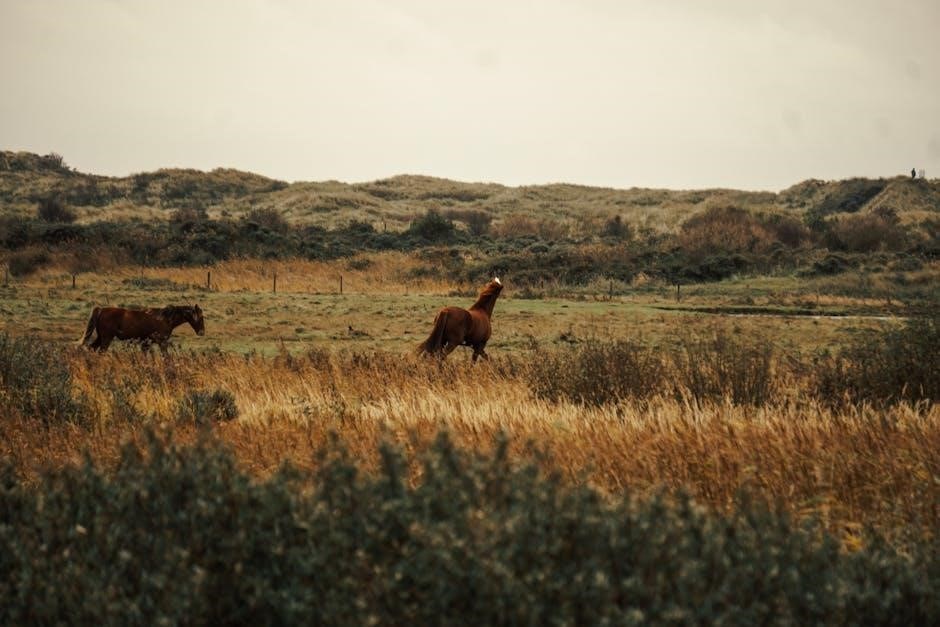The Peterson Field Guide to Mushrooms is a comprehensive resource for identifying fungi across North America, offering detailed coverage of edible and poisonous species. Its portable design and simple, non-technical approach make it accessible to both beginners and experienced mycologists; With hundreds of illustrations and a focus on key observable features, this guide has become a trusted tool for mushroom enthusiasts and foragers alike.
Overview of the Guide
The Peterson Field Guide to Mushrooms provides a detailed yet accessible overview of North America’s fungi, focusing on common edible and poisonous species. Its simple, non-technical approach emphasizes key features for identification, eliminating the need for a microscope. The guide includes hundreds of illustrations, enhancing visual learning. Designed for portability, it caters to both beginners and intermediate mycologists, offering a comprehensive yet user-friendly resource for field identification and understanding the diverse world of mushrooms.
Importance of Mushroom Identification
Accurate mushroom identification is crucial for safety, as distinguishing edible species from poisonous ones can prevent serious harm. The Peterson Guide emphasizes this by highlighting key features, ensuring users can confidently identify mushrooms without technical expertise. This skill is vital for foragers, outdoor enthusiasts, and mycologists, fostering a deeper appreciation for nature while minimizing risks associated with misidentification. The guide’s clear approach makes it an essential tool for anyone exploring the fascinating yet potentially dangerous world of fungi.

Background and History of the Peterson Field Guide
The Peterson Field Guide series, established over 85 years ago, is a trusted authority in field identification. The second edition of the mushroom guide, published in 2017, builds on this legacy with contributions from renowned mycologists, ensuring a comprehensive and reliable resource for fungi enthusiasts.
Development and Editions
The Peterson Field Guide to Mushrooms has evolved through editions, with the second edition published in 2017. It was developed by Karl B. McKnight, Joseph R. Rohrer, Kirsten McKnight Ward, and Kent H. McKnight, building on the legacy of Kent H. McKnight’s original work. This edition introduced a new identification method based on key features, expanded illustrations, and a quick guide for easy navigation. It covers 685 species, enhancing its utility for both beginners and advanced users.
Authors and Contributors
The Peterson Field Guide to Mushrooms was authored by Karl B. McKnight, Joseph R. Rohrer, Kirsten McKnight Ward, and Kent H. McKnight. Karl B. McKnight, a renowned mycologist, led the development of the second edition, building on Kent H. McKnight’s original work. Joseph R. Rohrer contributed significantly to the guide’s expansion, while Kirsten McKnight Ward enhanced its design and accessibility. Their collective expertise in mycology and botanical illustration ensures the guide’s accuracy and user-friendly approach, making it a trusted resource for mushroom enthusiasts.

Approach to Mushroom Identification
The Peterson Field Guide employs a straightforward method focused on observable features, eliminating the need for technical terms or specialized equipment, making mushroom identification accessible to everyone.
Key Features for Identification
The guide emphasizes a simple, non-technical approach, focusing on observable features like size, shape, color, and habitat. It avoids microscopic analysis, making identification accessible to all skill levels. Hundreds of detailed illustrations, including watercolors, aid in recognizing species. The portable design ensures it’s easy to carry during fieldwork. By covering both edible and poisonous mushrooms, the guide provides essential information for safe and accurate identification, catering to beginners and experienced foragers alike.
Simple Method Without Technical Vocabulary
The Peterson Field Guide uses a straightforward approach to mushroom identification, eliminating the need for technical terms or microscopic analysis. This method focuses on observable characteristics like size, shape, and color, making it accessible to everyone. By simplifying the process, the guide empowers users to identify mushrooms confidently, whether they’re beginners or experienced foragers. This user-friendly approach ensures that anyone can navigate the world of fungi without prior expertise, fostering a deeper connection with nature.

Key Features of the Guide
The Peterson Field Guide features a portable design, comprehensive coverage of edible and poisonous species, and detailed illustrations. Its simple identification method and user-friendly approach make it accessible to all.
Identification Method
The Peterson Field Guide uses a simple, non-technical approach to mushroom identification, focusing on key observable features like size, shape, color, and habitat. This method eliminates the need for a microscope or specialized vocabulary, making it accessible to all skill levels. By emphasizing easily noticeable characteristics, the guide helps users quickly narrow down species. Its innovative approach ensures accuracy and confidence, whether identifying edible or poisonous mushrooms, making it a reliable tool for both beginners and experienced foragers.
Illustrations and Visual Aids
The Peterson Field Guide features detailed watercolor illustrations and additional visuals, enhancing its effectiveness for mushroom identification. These images, including hundreds of new additions, provide clear depictions of species characteristics, making it easier to distinguish between similar fungi. The guide’s visual aids complement its text, offering a user-friendly experience for both beginners and experienced mycologists. This combination of art and science ensures accurate and efficient identification, even for those without advanced technical knowledge.
Portability and Design
The Peterson Field Guide is designed for portability, making it easy to carry on hikes or camping trips. Its compact size and lightweight format ensure it’s always accessible in the field. The guide’s durable design withstands outdoor conditions, while its clear layout and organization enhance usability. This practical tool balances portability with comprehensive information, offering a user-friendly experience for both casual enthusiasts and serious mycologists. Its design ensures it remains a reliable companion for mushroom identification in various settings.
Innovations in the Second Edition
The second edition introduces significant enhancements, including hundreds of additional illustrations and expanded coverage of 685 species. It incorporates a new, innovative approach to identification based on five key features observable in the field. This edition also includes a Quick Guide and improved organization, making it more user-friendly. The updated content ensures a broader range of edible and poisonous mushrooms are covered, while maintaining the guide’s portability and accessibility for both beginners and advanced users.
Coverage of Mushroom Species
The guide covers 685 species, including common edible and poisonous mushrooms, toadstools, truffles, boletes, and morels, providing a comprehensive overview of North America’s diverse fungal variety.
Edible Mushrooms
The guide provides detailed coverage of common edible mushrooms, offering descriptions and illustrations to help users safely identify species for foraging. It emphasizes North America’s diverse edible varieties, ensuring clarity for enthusiasts. The portable format and simple approach make it ideal for outdoor use, while the focus on key features aids in accurate identification without technical jargon or equipment. This section is invaluable for foragers and cooks seeking to explore wild mushrooms confidently and responsibly.
Poisonous Mushrooms
The guide thoroughly addresses poisonous mushrooms, emphasizing safety and clear identification to prevent accidental ingestion. It highlights key features and visual cues to distinguish harmful species, ensuring users can avoid dangerous varieties. With detailed descriptions and illustrations, the section on poisonous mushrooms serves as a critical resource for foragers and outdoor enthusiasts, promoting awareness and caution. This focus underscores the guide’s commitment to safe and responsible mushroom exploration.
Range and Variety of Species
The Peterson Field Guide to Mushrooms covers an extensive range of species, including 685 varieties across the United States and Canada. It spans common edible mushrooms, poisonous species, and lesser-known fungi, such as toadstools, truffles, boletes, and morels. This comprehensive coverage ensures that users can identify a wide diversity of mushrooms, making it an invaluable resource for both casual enthusiasts and dedicated researchers. The guide’s breadth highlights the rich fungal diversity across North America.

Target Audience
The Peterson Field Guide to Mushrooms is designed for beginners and intermediate mycologists, as well as foragers and outdoor enthusiasts seeking to identify fungi accurately and safely.
Beginners and Intermediate Mycologists
The Peterson Field Guide to Mushrooms is an ideal tool for both beginners and intermediate mycologists. Its simple, non-technical approach to identification, based on key observable features, makes it accessible to those new to mushroom hunting. The guide’s portability and detailed illustrations, including hundreds of added visuals in the second edition, help users recognize species confidently. With coverage of 685 species, it provides a comprehensive yet approachable resource for learners at every stage of mycological exploration.
Foragers and Outdoor Enthusiasts
The Peterson Field Guide to Mushrooms is a vital companion for foragers and outdoor enthusiasts, offering a portable and user-friendly resource for identifying edible and poisonous species. Its focus on key features and lack of technical vocabulary makes it accessible to those with varying levels of expertise. The guide’s detailed illustrations and coverage of common species ensure that foragers can confidently identify mushrooms in the field, enhancing their outdoor experiences and culinary adventures.

User Reviews and Testimonials
Readers praise the Peterson Field Guide for its clarity and portability, with many highlighting its essential role in mushroom identification for both beginners and experts alike.
Reader Feedback
Readers have praised the Peterson Field Guide for its clarity and portability, making it an essential tool for mushroom enthusiasts. Many highlight its effectiveness for beginners, emphasizing how the simple identification method builds confidence. The addition of hundreds of illustrations has been particularly well-received, aiding in accurate species recognition. Users appreciate the guide’s comprehensive coverage of both edible and poisonous mushrooms, while its compact size makes it ideal for field use. Overall, it is celebrated as a trusted resource for mycologists of all levels.
Expert Opinions
Experts highly recommend the Peterson Field Guide for its comprehensive coverage of North American mushrooms, praising its innovative approach to identification. The guide’s focus on key observable features without requiring technical expertise makes it accessible to a broad audience. Mycologists and field experts commend its detailed illustrations and portability, noting its value for both beginners and advanced users. The second edition’s enhancements, including additional species and improved visuals, solidify its reputation as a leading resource in the field of mycology.

Structure and Organization
The guide features a quick guide and index for easy navigation, with species organized logically to enhance accessibility and efficient identification for users of all skill levels.
Quick Guide and Index
The Peterson Field Guide features a handy Quick Guide on the inside front cover, enabling users to swiftly locate specific mushroom types. This tool streamlines the identification process, allowing for direct access to detailed species information. The comprehensive index further enhances navigation, ensuring that readers can quickly find entries for both common and lesser-known fungi. These organizational elements make the guide highly user-friendly, catering to both novice and experienced mycologists seeking efficient and accurate mushroom identification in the field.
Species Organization
The Peterson Field Guide organizes species logically, making it easy for users to navigate. It covers 685 species, including common edible and poisonous mushrooms, ensuring a wide range of fungi is represented. The guide uses an innovative method based on key features, allowing for efficient identification without requiring technical expertise. This approach caters to both beginners and advanced mycologists, providing a clear and accessible way to explore the world of mushrooms.
Comparison with Other Field Guides
The Peterson Field Guide stands out for its portability, simple identification method, and extensive illustrations, making it a top choice among field guides for mushroom enthusiasts.
Unique Selling Points
- Portable size for easy field use.
- Simple identification method without technical vocabulary.
- Extensive illustrations, including new additions in the second edition.
- Covers both edible and poisonous species comprehensively.
- Accessible to beginners while still valued by experts.
Market Position
The Peterson Field Guide to Mushrooms is widely regarded as the ultimate, most comprehensive guide to North American fungi. Its portability, simple identification method, and extensive illustrations make it a top choice for both beginners and experts. With over 85 years of setting standards, it remains a trusted resource, solidifying its reputation as an indispensable tool for mushroom enthusiasts and professionals alike.

Practical Use in the Field
The guide’s portable size and simple identification method make it ideal for field use, allowing quick and accurate mushroom identification without needing technical tools or vocabulary.
Field Identification Tips
The guide emphasizes observing key features like size, shape, color, and habitat to identify mushrooms accurately. Its portability and simple approach make it ideal for field use, allowing quick comparisons without technical tools. The inclusion of detailed illustrations and a quick guide helps users narrow down species efficiently. Suitable for all skill levels, it ensures that both beginners and experienced foragers can confidently identify mushrooms while exploring the outdoors.
Best Practices for Mushroom Hunting
When hunting for mushrooms, always carry the Peterson Field Guide for quick reference. Examine the habitat and observe key features like cap shape, gills, and stem color. Be cautious with edible species, as some can be poisonous. Use the guide’s illustrations and descriptions to cross-verify findings. Practice sustainable foraging by only collecting what’s needed and avoiding over-harvesting. This approach ensures both enjoyable and responsible mushroom hunting experiences in the field.

Tips for Effective Use
Use the guide’s quick reference and index for fast species lookup. Study the key features and illustrations to enhance identification accuracy. Carry it on hikes for easy access and cross-referencing in the field.
For Beginners
The Peterson Field Guide is an excellent starting point for newcomers to mycology. Its simple, non-technical approach and detailed illustrations make identifying mushrooms accessible. Beginners can quickly learn to recognize species using the guide’s key features, avoiding the need for specialized equipment. The portable size and clear organization ensure ease of use in the field. By focusing on common edible and poisonous mushrooms, it builds confidence and knowledge for those just beginning their foraging journey.
For Advanced Users
The Peterson Field Guide caters to advanced users by offering in-depth details on over 685 species, including rare and lesser-known varieties. Its comprehensive approach, combined with enhanced illustrations, provides experts with a reliable reference for precise identification. The guide’s updated second edition includes additional species and refined descriptions, making it a valuable resource for advanced mycologists seeking to expand their knowledge and refine their identification skills in the field.

The Peterson Field Guide to Mushrooms stands as a trusted, comprehensive resource for identifying fungi, offering a portable and user-friendly approach for both beginners and experienced mycologists.
Final Thoughts
The Peterson Field Guide to Mushrooms is an indispensable tool for anyone exploring the world of fungi. Its portable design, simple identification method, and extensive illustrations make it accessible to all skill levels. The second edition’s enhanced features and expanded species coverage solidify its reputation as a trusted resource. Whether for beginners or experienced mycologists, this guide remains a cornerstone for mushroom enthusiasts, offering unparalleled clarity and depth in fungal identification.
Recommendation
Highly recommended for both beginners and intermediate mycologists, the Peterson Field Guide to Mushrooms is an essential tool for anyone interested in fungi. Its portable size, simple identification method, and extensive illustrations make it a standout resource. Whether for casual foraging or deeper mycological study, this guide provides unmatched clarity and accessibility. It is a must-have for anyone seeking to explore and understand the diverse world of mushrooms with confidence and accuracy.